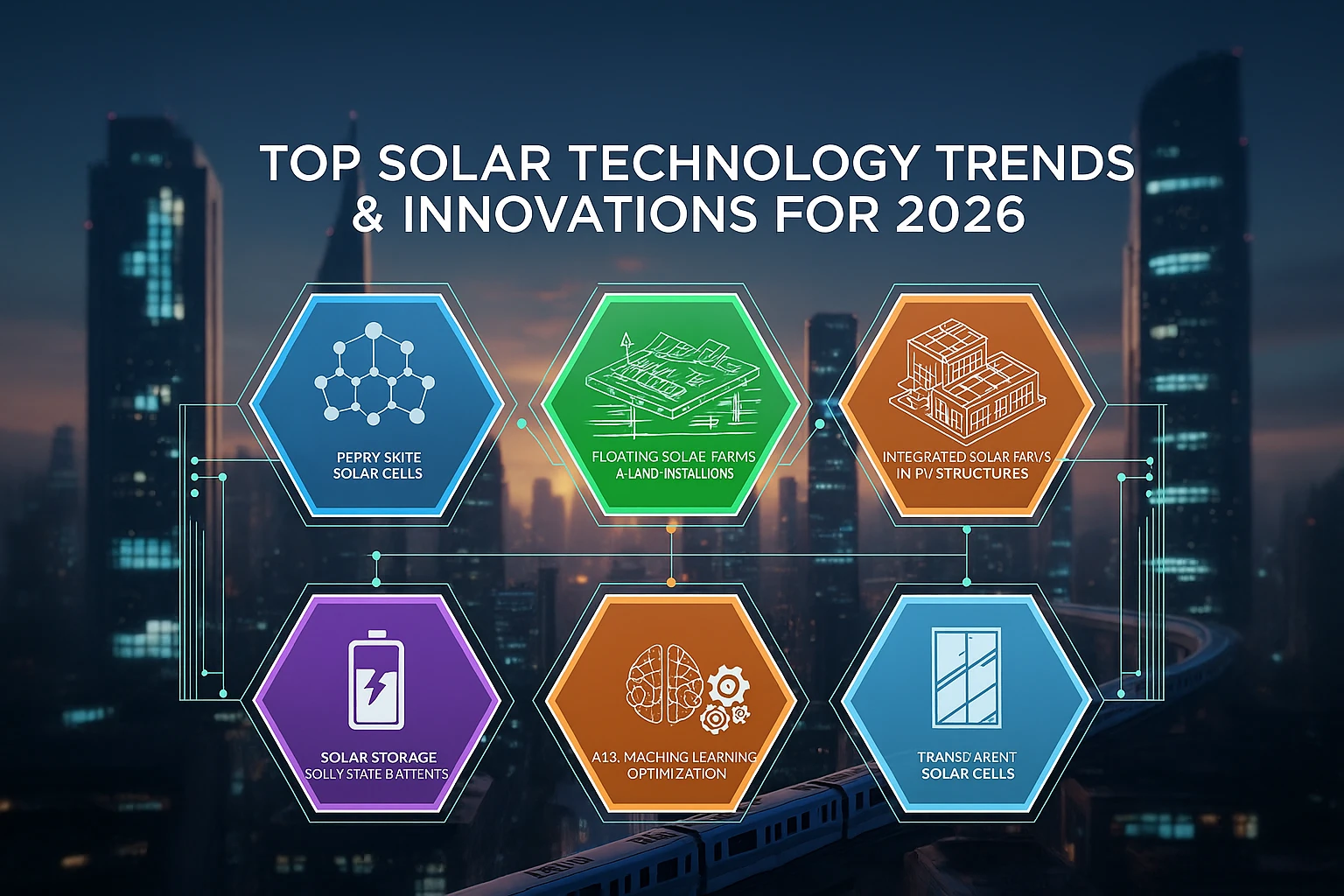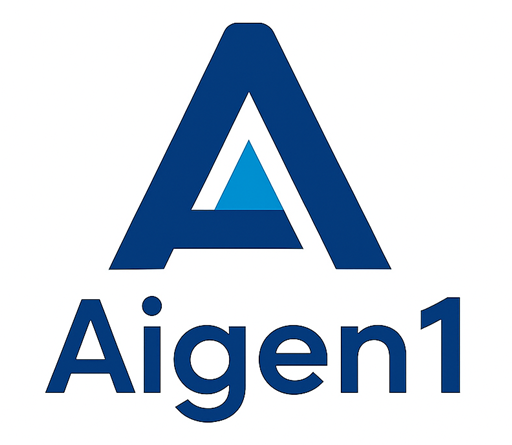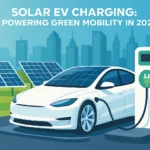Top Solar Technology Trends
As we stand on the cusp of 2026, solar technology continues to illuminate the path toward a sustainable future. From the sun-drenched panels of today to the revolutionary innovations on the horizon, the solar industry is poised for exponential growth. Moreover, with global photovoltaic (PV) installations projected to reach new heights despite short-term challenges, experts predict solar will surpass wind as the leading renewable source by mid-decade. This article explores the Top Solar Technology Trends shaping 2026, from perovskite breakthroughs to AI-optimized grids, highlighting how innovation is accelerating the global transition to clean energy.
In addition, advancements in materials, integration, and intelligence are driving efficiencies that make solar not just viable, but essential. However, policy shifts, such as the expiration of key tax credits in the US, add layers of complexity. Consequently, stakeholders—from homeowners to policymakers—must adapt to harness this solar surge. By delving into these innovations, we uncover how solar will power economies, combat climate change, and redefine energy access worldwide.

Top Solar Technology Trends
The Evolving Landscape of Solar Energy
Global Market Outlook for 2026
The solar market in 2026 promises a dynamic blend of growth and recalibration. According to recent forecasts, global solar additions may experience a brief stagnation, particularly in China, as new market designs take effect. Nevertheless, overall installations are expected to rebound strongly, with the US alone adding an average of 43 GW annually through 2030. Furthermore, emerging markets like India are accelerating, targeting one crore rooftop solar plants by 2026-27 under initiatives like PM Surya Ghar Muft Bijli Yojana. In contrast, policy uncertainties in the West could temper enthusiasm; for instance, the US 30% tax credit phases out, mandating more domestic manufacturing.
However, this shift fosters innovation, pushing companies toward resilient supply chains. Consequently, residential solar adoption surges, driven by falling costs and grid reliability issues. Moreover, AI’s role in forecasting demand will optimize deployments, ensuring solar meets over 90% of global electricity growth alongside wind. As a result, the industry’s trajectory points to decarbonization and energy security, with solar emerging as the fastest-growing technology.
Top Solar Technology Trends
Challenges and Opportunities Ahead
Transitioning into 2026, solar faces hurdles like module oversupply and geopolitical tensions, yet these catalyze creativity. For example, single-digit growth rates in some regions highlight the need for diversification. In addition, raw material scarcities, such as silver for panels, pose risks, but recycling innovations mitigate them. On the brighter side, investments in battery energy storage systems (BESS) and transmission infrastructure signal bullish sentiment.
Furthermore, the integration of solar with electric vehicles (EVs) accelerates, with EVs becoming cheaper than internal combustion engines by 2026. Thus, opportunities abound in smart grids and distributed energy. Overall, while challenges persist, they underscore solar’s adaptability, setting the stage for transformative trends.
Trend 1: The Perovskite Revolution
What Are Perovskite Solar Cells?
Perovskite solar cells represent a game-changer in photovoltaic technology, named after their crystal structure resembling the mineral perovskite. Unlike traditional silicon cells, these use hybrid organic-inorganic materials that absorb light more efficiently across the spectrum. By 2026, companies will scale production, with panels hitting the market at competitive prices. Moreover, their low-cost fabrication via printing techniques democratizes access, potentially slashing manufacturing expenses by 50%.
However, stability has been a concern, as perovskites degrade under moisture and heat. Recent breakthroughs in encapsulation address this, extending lifespans to 25 years. In addition, tandem configurations pairing perovskites with silicon boost efficiencies beyond 30%, far surpassing current 22% averages. Consequently, perovskites could dominate residential and commercial installations by late 2026.
Benefits and 2026 Predictions
The allure of perovskites lies in their versatility and performance. For instance, they capture light in ways silicon cannot, enabling thinner, flexible panels ideal for curved surfaces or wearables. Furthermore, with efficiencies projected at 35% in lab settings, real-world applications will see 28-30% by 2026, revolutionizing energy yields.
Yet, scaling remains key; pilot projects in Europe and Asia are paving the way. As a result, global adoption could add 100 GW of capacity annually. Thus, perovskites not only enhance output but also align with sustainability goals by using abundant materials.
Top Solar Technology Trends
Challenges in Commercialization
Despite promise, commercialization hurdles persist. For example, toxicity in some perovskite formulations raises environmental flags, prompting research into lead-free alternatives. Moreover, supply chain integration with existing silicon lines demands investment. However, firms like First Solar are innovating with programs like CuRe, promising durable, high-output modules. By 2026, these efforts will yield certified products, bridging lab-to-market gaps. In conclusion for this trend, perovskites herald a brighter, more efficient solar era.
Trend 2: Bifacial Panels and Advanced Designs
Rise of Bifacial Technology
Bifacial solar panels, capturing sunlight from both sides, are set to proliferate in 2026. These designs harness reflected light from surfaces like snow or water, boosting energy capture by 10-30%. In addition, with costs dropping due to manufacturing efficiencies, bifacials will dominate utility-scale farms.
Furthermore, innovations like solar panel carports integrate seamlessly into urban infrastructure, providing shade while generating power. Consequently, cities worldwide will see widespread adoption, reducing urban heat islands. Thus, bifacials exemplify how design tweaks amplify solar’s impact.
Top Solar Technology Trends
Innovations in Panel Aesthetics
Beyond functionality, aesthetics drive advanced designs. Solar shingles and tiles, mimicking traditional roofing, blend renewables into architecture. By 2026, these will feature built-in batteries for off-grid resilience. However, challenges like higher upfront costs persist, though subsidies ease them. Moreover, transparent panels for windows open building-integrated photovoltaics (BIPV) markets. As a result, residential solar becomes stylish and ubiquitous, transforming homes into power plants.
Efficiency Gains and Applications
Efficiency is paramount in advanced panels. Tandem cells, combining perovskites with bifacials, push limits to 40%. For instance, in agrivoltaics, elevated bifacials allow dual land use for farming and energy. In addition, space-based solar benefits from radiation-resistant designs. Therefore, 2026 will see diversified applications, from deserts to oceans, solidifying solar’s versatility.
Overall, bifacial and advanced designs underscore solar’s maturation, blending form, function, and future-proofing.
Top Solar Technology Trends
Trend 3: Solar + Storage Integration
The Boom in Battery Energy Storage Systems (BESS)
Integration of solar with storage is a cornerstone trend for 2026. BESS, pairing panels with lithium-ion or flow batteries, addresses intermittency, enabling 24/7 clean power. Moreover, costs have plummeted 89% since 2010, making hybrid systems affordable for homes.
However, long-duration storage innovations, like iron-air batteries, extend discharge to days. Consequently, utilities will deploy gigawatt-scale BESS to stabilize grids amid rising EV demand. Thus, this synergy powers the energy transition.
Top Solar Technology Trends
Smart Storage Solutions
Smart features elevate BESS. AI algorithms predict usage, optimizing charge-discharge cycles for peak savings. In addition, vehicle-to-grid (V2G) tech turns EVs into home batteries. By 2026, residential setups with solar-plus-storage will cut bills by 70%. Furthermore, policy incentives in India and the US accelerate rollout. As a result, storage becomes indispensable, fostering energy independence.
Top Solar Technology Trends
Future of Grid-Scale Storage
At grid scale, BESS tackles renewables’ variability. For example, New Zealand anticipates 800 GWh of solar-BESS online in 2026. Yet, material shortages challenge expansion, spurring alternatives like sodium-ion. Moreover, hydrogen hybrids emerge for seasonal storage. Hence, 2026 marks BESS as solar’s steadfast partner.
Trend 4: AI-Driven Optimization in Solar
Harnessing AI for Efficiency
Artificial intelligence transforms solar operations in 2026. AI optimizes panel angles via drones, increasing yields by 25%. Furthermore, predictive analytics forecast weather impacts, minimizing downtime.
However, edge computing enables real-time adjustments in remote farms. In addition, AI aids supply chain management, countering oversupply. Consequently, operational costs drop, making solar competitive with fossils.
AI in Design and Maintenance
In design, AI simulates millions of configurations for custom panels. For maintenance, machine learning detects faults via thermal imaging, extending lifespans. By 2026, AI-integrated systems will dominate, powering data centers for AI itself—a virtuous cycle. Thus, intelligence amplifies solar’s scalability.
Broader Implications for Energy Systems
Broadly, AI fosters smart grids, balancing solar influx with demand. Moreover, in emerging markets, AI democratizes monitoring via apps. However, data privacy concerns arise, necessitating robust frameworks. As a result, AI positions solar as a cornerstone of intelligent energy ecosystems in 2026.
Trend 5: Floating Solar Farms
Advantages of Water-Based Installations
Floating solar photovoltaic (FPV) systems mount panels on water bodies, saving land while cooling panels for 10% higher efficiency. In 2026, FPV capacity will triple, especially in Asia’s reservoirs. Furthermore, they reduce evaporation by 70%, aiding water-scarce regions.
However, anchoring in turbulent waters poses engineering challenges. Consequently, modular designs emerge, enabling quick deployment. Thus, FPV redefines solar’s footprint.
Global Expansion and Innovations
Expansion accelerates in India and Africa, hybridizing with hydro dams. Innovations like flexible floats withstand waves. In addition, bifacial FPV captures underwater reflections. By 2026, FPV will contribute 5% of new solar, promoting biodiversity-friendly energy.
Moreover, economic models show 20% lower levelized costs. Therefore, floating farms float to prominence.
Environmental and Economic Impacts
Environmentally, FPV enhances aquatic ecosystems by shading algae blooms. Economically, it unlocks untapped sites. Yet, marine impacts require monitoring. As a result, 2026 guidelines will standardize FPV, ensuring sustainable scaling.
Trend 6: Solar in Emerging Markets
India’s Rooftop Revolution
India leads with ambitious targets, installing 10 million rooftop systems by 2026. Subsidies under PM Surya Ghar drive affordability. Furthermore, local manufacturing booms, creating jobs.
However, grid integration lags in rural areas. In addition, microgrids empower off-grid villages. Consequently, solar fosters inclusive growth.
Opportunities in Africa and Beyond
Africa’s solar potential is vast, with mini-grids lighting remote communities. By 2026, investments will surge via green bonds. Moreover, pay-as-you-go models lower barriers. Thus, emerging markets become solar powerhouses, bridging energy divides.
Policy and Investment Drivers
Policies like net metering accelerate uptake. Investments in transmission, like India’s lines, support scale. However, financing gaps persist. As a result, blended finance innovates solutions for 2026.
Trend 7: Sustainability and Recycling in Solar
Circular Economy for Panels
Sustainability focuses on lifecycle management. By 2026, 95% recyclable panels will dominate, recovering silver and silicon. Recycling hubs in Europe set standards. Furthermore, biodegradable backsheets reduce waste.
However, collection logistics challenge scalability. Consequently, AI tracks end-of-life assets. Thus, solar minimizes its footprint.
Green Manufacturing Practices
Manufacturing goes green with low-carbon processes. Solar-powered factories cut emissions 50%. In addition, ethical sourcing avoids conflict minerals. By 2026, certifications verify sustainability. Moreover, this trend attracts ESG investors.
Long-Term Environmental Benefits
Ultimately, sustainable solar combats climate change effectively. Reduced mining via recycling preserves ecosystems. Therefore, 2026 cements solar’s eco-credentials.
Top Solar Technology Trends
Conclusion
In summary, 2026 heralds a solar renaissance, propelled by perovskites, AI, storage, and global expansion. These trends not only boost efficiency but also ensure equity and resilience. However, success hinges on collaborative policies and innovations. As solar meets surging demands—from AI data centers to EVs—it illuminates a net-zero future. Moreover, with renewables topping power sources, the sun’s power is unstoppable. Stakeholders, embrace these shifts; the dawn of sustainable energy awaits.
For broader insights on technology’s role in sustainability, explore Top Tech Innovations Tackling Climate Change in 2026.
Frequently Asked Questions (FAQs)
Top Solar Technology Trends
1. What are the top solar technology trends for 2026?
In 2026, key trends include perovskite solar cells, bifacial panels, solar-plus-storage systems, AI-driven optimization, floating solar farms, expansion in emerging markets like India and Africa, and sustainable panel recycling. These advancements enhance efficiency, affordability, and environmental impact.
2. Why are perovskite solar cells a big deal for 2026?
Perovskite cells achieve higher efficiencies (up to 30% in real-world use) and lower costs than silicon. By 2026, improved durability and scalability will make them a go-to choice for homes and businesses.
3. How do bifacial solar panels improve energy capture?
Bifacial panels absorb sunlight from both sides, using reflected light from surfaces like water or snow. This boosts output by 10-30%, making them a staple for large-scale and urban projects by 2026.
4. Why is energy storage critical for solar in 2026?
Battery energy storage systems (BESS) store solar power for continuous use, solving intermittency. By 2026, affordable batteries and AI optimization will make solar-plus-storage systems vital for homes and grids.
5. How will AI shape solar technology in 2026?
AI enhances solar by optimizing panel angles, predicting maintenance, and managing grid demand. By 2026, AI tools will increase energy yields by 25% and cut costs, boosting solar’s competitiveness.
6. What makes floating solar farms a growing trend?
Floating solar farms (FPV) save land and improve efficiency by 10% through water cooling. By 2026, their capacity will triple in Asia and Africa, supporting energy and water conservation goals.
7. How is solar expanding in emerging markets?
India targets 10 million rooftop solar systems by 2026 with subsidies, while Africa uses mini-grids and pay-as-you-go models. These efforts drive energy access and economic growth in developing regions.
8. What sustainability efforts are planned for solar in 2026?
By 2026, 95% recyclable panels and green manufacturing will reduce waste and emissions. Recycling hubs and biodegradable materials will align solar with circular economy principles, minimizing environmental impact.
9. What challenges could slow solar growth in 2026?
Module oversupply, material shortages, and policy changes like expiring tax credits pose risks. However, innovations in recycling, alternative materials, and AI efficiencies will help address these challenges.
10. How will solar contribute to global energy goals by 2026?
Solar will lead renewable growth, covering over 90% of new electricity demand with wind. Enhanced efficiency and storage will drive decarbonization and energy security worldwide by 2026.


